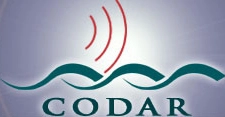
CODAR Ocean Sensors
1914 Plymouth Street, , Mountain View , California, United States

Since Mar, 2015
CODAR Ocean Sensors, located in Mountain View, California, conducts research, design, manufacturing and support of high frequency (HF) radar systems primarily for ocean current and wave monitoring.
CODAR founders began working in the field of HF radar as early as the 1960's. In 1968, Donald Barrick (future co-founder and President of CODAR Ocean Sensors) established the theoretical basis of HF sea scatter that allows both current extraction as well as sea state monitoring. During the early 1970s, Barrick and others, working in the U.S. Department of Commerce (NOAA) research laboratories, demonstrated the utility and accuracy of these measurements with large phased array radars.
From then until 1984, Barrick led a research team within NOAA's Wave Propagation Laboratory that demonstrated the feasibility and accuracy of smaller, transportable, HF radars for real-time current mapping to distances 60 km from shore. In 1984 the core team that invented these systems left the Government to eventually form what became CODAR Ocean Sensors CODAR , developing low-CODAR t commercial versions. Over the past 30 years, hundreds of journal papers have appeared that explain the techniques and establish accuracies by independent comparisons.
CODAR Today
The CODAR design of the 1980's has been improved upon over the last 20 years and is now replaced with the SeaSonde®. The SeaSonde is the only commercially available HF radar system with a proven track record and stands at the forefront of precision current measurement and ease of utility. Designed and built by CODAR Ocean Sensors, the SeaSondes have a small antenna footprint, low power output and 360 degree possible viewing angle which minimizes siting constraints and maximizes coverage area. They can be remotely controlled from a central computer in your office and set for scheduled automatic data transfers. The SeaSonde is ideal for fine scale monitoring in ports and small bays, as well as open ocean observation over larger distances up to 70 km. For extended coverage, the Long-Range SeaSonde can observe currents as far as 200 km offshore..
The Unique Nature of HF Radar
High-frequency (HF) radio formally spans the band 3-30 MHz (with wavelengths between 10 meters at the upper end and 100 meters at the lower end). For our radars, we extend the upper limit to 50 MHz. A vertically polarized HF signal is propagated at the electrically conductive ocean water surface, and can travel well beyond the line-of-sight, beyond which point more common microwave radars become blind. Rain or fog does not affect HF signals.
The ocean is a rough surface, with water waves of many different periods. When the radar signal hits ocean waves that are 3-50 meters long, that signal scatters in many directions. In this way, the surface can act like a large diffraction grating.
But, the radar signal will return directly to its source only when the radar signal scatters off a wave that is exactly half the transmitted signal wavelength, AND that wave is traveling in a radial path either directly away from or towards the radar. The scattered radar electromagnetic waves add coherently resulting in a strong return of energy at a very precise wavelength. This is known as the Bragg principle, and the phenomenon 'Bragg scattering'. At the SeaSonde's HF/VHF frequencies (4-50 MHz), the periods of these Bragg scattering short ocean waves are between 1.5 and 5 seconds.
What makes HF RADAR particularly useful for current mapping is that the ocean waves associated with HF wavelengths are always present. The following chart shows three typical HF operating frequencies and the corresponding ocean wavelengths that produce Bragg scattering.
25 MHz transmission -> 12m EM wave -> 6m ocean wave
12 MHz transmission -> 25m EM wave -> 12.5m ocean wave
5 MHz transmission -> 60m EM wave -> 30m ocean wave
So far three facts about the Bragg wave are known: its wavelegnth, period, and travel direction. Because we know the wavelength of the wave, we also know it's speed very precisely from the deep water dispersion relation.
The returning signal exhibits a Doppler-frequency shift. In the absence of ocean currents, the Doppler frequency shift would always arrive at a known position in the frequency spectrum.
But the observed Doppler-frequency shift does not match up exactly with the theoretical wave speed. The Doppler-frequency shift includes the theoretical speed of the speed of the wave PLUS the influence of the underlying ocean current on the wave velocity in a radial path (away from or towards the radar).
The effective depth of the ocean current influence on these waves depends upon the waves period or length. The current influencing the Bragg waves falls within the upper meter of the water column (or upper 2.5 meters when transmitting between 4-6 MHz). So, once the known, theoretical wave speed is subtracted from the Doppler information, a radial velocity component of surface current is determined.
By looking at the same patch of water using radars located at two or more different viewing angles, the surface current radial velocity components can be summed to determine the total surface current velocity vector.
Is it that simple?
The basic physics relating the HF radar signal to the nature of the ocean waves and currents is beautifully simplistic, but the task of mapping surface currents with a modern radar sensor is more complex.
Continue reading for more details.
| Company Name | CODAR Ocean Sensors |
| Business Category | Energy |
| Address | 1914 Plymouth Street, Mountain View California United States |
| President | NA |
| Year Established | NA |
| Employees | NA |
| Memberships | NA |
| Hours of Operation | NA |
- Seasonde
- Riversonde
| Phone Number | Locked content | Subscribe to view |
| Fax Number | Locked content | |
| Locked content | ||
| Website | Locked content |